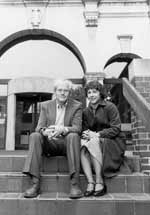After sharing their lives with thousands of graduate students at Ashdown House over the last 16 years, housemasters Beth and Vernon Ingram are moving down the river to 100 Memorial Dr., where they'll continue to share a portion of their time as house fellows at Tang Hall.
They'll leave a few traditions behind at Ashdown and take with them memories of their time as friends and hosts to the 400-plus students living in the dorm at any given time.
"The housemasters are there generally to help out rather than take a strong hand in governance," said Stephen Evangelides (PhD in physics, 1989), who headed the Ashdown committee that selected the Ingrams in 1985. "In a tradition going back to Avery Ashdown, one of the biggest things is to try to help students balance work with a social life. Housemasters play a mediating force to the graduate student's tendency to work all day and all night.
"The Ingrams were very low-key but very determined people," he added. "They started slowly, but they really opened themselves up and shared all the things they liked, bringing with them a whole new set of traditions to the house." Those traditions include musical brunches, with students entertaining on the piano in the Ingrams' suite or on other instruments, and art shows, where students are encouraged to hang their original artwork in the house.
"They coaxed out of everybody all the other dimensions of their personalities," said Dr. Evangelides. "I have a tremendous amount of admiration for Vernon and Beth."
"Vernon has always loved talking with students, particularly MIT students," said Beth Ingram. "He loves listening to their ideas, challenging them and being challenged back. I soon found that I did, too."
Dr. Ingram, the John and Dorothy Wilson Professor of Biology, was born in Germany and educated at London University. His familiarity with non-American cultures helped the Ingrams make Ashdown students who were not originally from the United States (about 40 percent, according to Mrs. Ingram) feel more comfortable.
Part of our role "was to help the foreign students adjust to life in the United States," said Professor Ingram. "We could help them see how things are done here. But that's a two-way street, because they could show us how things are done in their countries.
"Graduate students can be very isolated in their labs. We wanted to create a place they can call home or home-like, and to give them confidence that we're there to help them. For instance, some of the students have trouble with their advisors. We can talk with the students about that because we're nonjudgmental and we know many of the faculty. Usually it's a question of working with the students and getting them to see what's possible and not possible -- what's to their advantage or disadvantage," he said.
In an online history of Ashdown House, John-Paul Mattia (SM 1992) writes: "Beth's southern charm and perfect hosting draws out the quietest of students. During my four times on the AHEC [Ashdown House Executive Committee], she taught me an enormous amount about people through her insightful comments. She has also had several brainstorms with enormous effects on the house. As an example: The Dean's office insisted on housing 50 undergraduates in Ashdown in the middle of a graduate housing shortage. Beth suggested that we invite a sorority. I laughed because I thought she was joking. However, it was a brilliant stroke. The sorority wanted its own house, and we wanted the spaces back, so everybody involved had the goal of returning the spaces to grad students. And the grooming habits of the Ashdown men noticeably improved."
"After living in the suburbs for several years, we were excited about the idea of living on campus, among students, where the action was," said Mrs. Ingram. "We soon found out just how much action there was."
Some of her favorite memories, she said, are sweet, like being asked to read a love poem at the wedding of former students, or sitting in the living room watching snow fall while listening to a student play the piano. Others are a little more invigorating -- "at age 50-plus, madly chasing 25-year-old males down ski slopes where it was 'keep up or get lost.'" She remembers "sharing the awfulness of Tiananmen Square with a group of Chinese residents" and "six weeks of nightly, highly emotional discussion centered around a certain student's predilection for wearing red panties -- and little else -- in a suite's kitchen."
"Occasionally you come across a difficult situation that you don't know how to resolve and you sort of muddle through," said Professor Ingram.
"They know all the history and all the stories about Ashdown," said Jennifer Farver, a graduate student in civil and environmental engineering who is current president of Ashdown House. "So when we're trying to make a decision like renting a house movie or having a barbecue, they know all the bad things that have happened in the past.
"Actually, the Ingrams set the culture for the house. Some students won't even come to social events unless they're hosted by the Ingrams," said Ms. Farver.
The house gave a farewell dinner for the Ingrams on May 18 as a way of showing thanks for 16 years of caring service.
A version of this article appeared in MIT Tech Talk on June 6, 2001.







